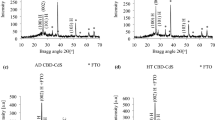Abstract
II–VI and IV–VI semiconductor films for solar cell applications, namely, CdTe, CdS, CdSe, PbS, PbSe and PbTe, can be prepared in a two-stage deposition process. In this work we illustrate the two-stage process to obtain PbTe and CdSe films from precursor oxide or hydroxide films deposited by chemical bath deposition (CBD). At the first stage, plumbonacrite Pb10(CO3)6O(OH)6 or cadmium oxide/hydroxide CdO2/Cd(O2)0.88(OH)0.24 films were deposited onto a glass substrate by CBD, using an ammonia-free low-temperature process in an alkaline aqueous solution with corresponding ion sources. Then, at the second stage, the obtained film was placed in a chemical vapor deposition (CVD) Hot Wall reactor with gas transportation, where it acted as a substrate in the reaction of isovalent substitution of Te or Se for the nonmetallic film component, thus forming PbTe and CdSe films. A nitrogen flux of 0.25 L/min was used as the transporting gas. The source temperature was adjusted between boiling (Tb) and melting point (Tm) to control the flux gas of the source. The substrate temperature was adjusted to improve film quality. Structural and optical investigation of the films proved their high quality, which determines the possibility of using them as solar cell elements, in particular, in multijunction cells.
Similar content being viewed by others
References
Vorobiev, Y.V., González-Hernández, J., Vorobiev, P., and Bulat, L., Thermal-photovoltaic solar hybrid system for efficient solar energy conversion, Sol. Energy, 2006, vol. 80, pp. 170–176.
Ellingson, R.J., Beard, M.C., Johnson, J.C., Yu, P., Micic, O.I., Nozik, A.J., Shabaev, A., Efros, A.L., Highly efficient multiple exciton generation in colloidal PbSe and PbS quantum dots, Nano Lett., 2005, vol. 5, pp. 865–871.
Dalven, R., A review of the semiconductor properties of PbTe, PbSe, PbS and PbO, Infrared Phys. Technol., 1969, vol. 9, pp. 141–181.
Al-Ani, S.K.J., Mohammed, H.H., and Al-Fwade, E.M.N., The optoelectronic properties of CdSe:Cu photoconductive detector, Renew. Energy, 2002, vol. 25, pp. 585–590.
Sushil Kumar et al., Studies on thin films of lead chalcogenides, Curr. Appl. Phys., 2005, vol. 5, pp. 561–566.
Baranyuk, V.Ye., Demych, M.V., Makhniy, V.P., et al., Isovalent substitution: perspective method of producing heterojunction optoelectronic devices, Proc. SPIE-Int. Soc. Opt. Eng., 2000, vol. 4425, pp. 272–277.
Makhniy, V.P., Slyotov, M.M., and Khusnutdinov, S.V., Luminescence of zinc oxide layers synthesized on zinc selenide substrates by the isovalent substitution method, Russ. Phys. J., 2009, vol. 52, no. 2.
Makhniy, V.P., Khusnutdinova, S.V., and Jakeła, R., Mechanism of ZnO heterolayer formation on ZnSe substrates, Inorg. Mater., 2011, vol. 47, no. 7, pp. 746–748.
Bernal-Martínez, J.A. and Ramirez-Bon, R. (in press).
Kungumadevi, L. and Subbarayan, R.S., AC conductivity and dielectric properties of thermally evaporated PbTe thin films, Solid-State Electron., 2010, vol. 54, pp. 58–62.
Dashevsky, Z., Kasiyan, V., Flitsiyan, E., and Chernyak, L., Influence of oxygen treatment on transport properties of PbTe:In polycrystalline films, Phys. B (Amsterdam, Neth.), 2010, vol. 405, pp. 2380–2384.
Yadav, A.A., Barote, M.A., and Masumdar, E.U., Studies on cadmium selenide (CdSe) thin films deposited by spray pyrolysis, Mater. Chem. Phys., 2010, vol. 121, pp. 53–57.
Kertoatmodjo, S. and Guastavino, N.F., Formation reactions of PbTe thin film deposition by close-spaced vapor transport (CSVT) technique, Thin Solid Films, 1998, vol. 324, pp. 25–29.
Ochoa-Landín, R., Castillo, S.J., and Ramíarez-Bon, R., Growth from solution of CdTe films by conversion of chemically deposited cadmium oxide hydroxide films, Sol. Energy, 2012, vol. 86, pp. 3326–3330.
Author information
Authors and Affiliations
Corresponding author
Additional information
Published in Russian in Neorganicheskie Materialy, 2014, Vol. 50, No. 6, pp. 591–596.
The article was translated by the authors.
Rights and permissions
About this article
Cite this article
Chávez Urbiola, I.R., Bernal Martínez, J.A., Makhniy, V.P. et al. Preparation of II–VI and IV–VI semiconductor films for solar cells by the isovalent substitution technique with a CBD-made substrate. Inorg Mater 50, 546–550 (2014). https://doi.org/10.1134/S002016851406003X
Published:
Issue Date:
DOI: https://doi.org/10.1134/S002016851406003X




